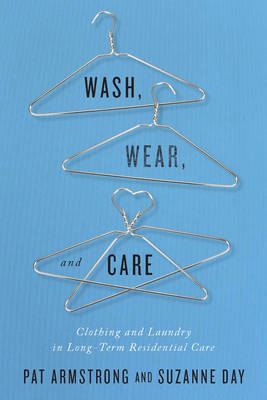
- Afhalen na 1 uur in een winkel met voorraad
- Gratis thuislevering in België vanaf € 30
- Ruim aanbod met 7 miljoen producten
- Afhalen na 1 uur in een winkel met voorraad
- Gratis thuislevering in België vanaf € 30
- Ruim aanbod met 7 miljoen producten
Zoeken
Wash, Wear, and Care
Clothing and Laundry in Long-Term Residential Care
Pat Armstrong, Suzanne Day
Hardcover | Engels
€ 163,95
+ 327 punten
Uitvoering
Omschrijving
Clothing and appearance are steeped in social and personal significance, conveying individuals' gender, class, culture, and occupation. In the communal setting of long-term residential care, where residents' autonomy and mobility are often limited but their dignity and identity are paramount, clothes have become crucial issues and the source of tension for residents, their families, and staff. Assessing the neglected but important labour involved in ensuring that clothes promote respect for both the washers and the wearers, Wash, Wear, and Care analyzes the roles that laundry and clothing play in nursing homes, and raises questions about the wider social, political, economic, and historical contexts of these facilities. Drawing on interviews and observations from twenty-seven long-term residential care homes across Canada, Germany, Norway, Sweden, the United Kingdom, and the United States, Pat Armstrong and Suzanne Day provide an extensive and vital base of information on the daily organization, tasks, meanings, and concerns associated with clothing, laundry, dressing, and appearance in care facilities. An original study of an overlooked subject, Wash, Wear, and Care illuminates the shifting political and economic dynamics at work in long-term residential care homes and the health care system, raising larger theoretical and policy questions in the process.
Specificaties
Betrokkenen
- Auteur(s):
- Uitgeverij:
Inhoud
- Aantal bladzijden:
- 216
- Taal:
- Engels
Eigenschappen
- Productcode (EAN):
- 9780773549227
- Verschijningsdatum:
- 24/04/2017
- Uitvoering:
- Hardcover
- Formaat:
- Genaaid
- Afmetingen:
- 152 mm x 229 mm
- Gewicht:
- 439 g

Alleen bij Standaard Boekhandel
+ 327 punten op je klantenkaart van Standaard Boekhandel
Beoordelingen
We publiceren alleen reviews die voldoen aan de voorwaarden voor reviews. Bekijk onze voorwaarden voor reviews.











